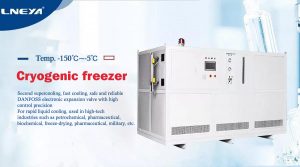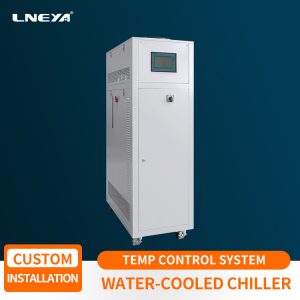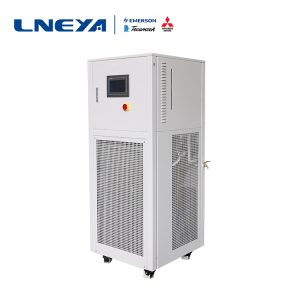Introduction Of Low Temperature Refrigeration Equipment Series-low Temp Process Chillers
Thermoacoustic refrigeration technology is a new refrigeration method with wide application prospects. It is one of the major advances in refrigeration and cryogenic technology in the past 30 years. Thermoacoustic engine uses thermoacoustic effect to convert thermal energy into acoustic energy, which can be used to drive thermoacoustic low temp process chillers. The combination of the two is called thermoacoustic driven refrigeration system. In thermoacoustic driven refrigeration system, when the temperature gradient of engine regenerator reaches its critical value, sound waves will be excited.
Acoustic wave makes gas micro-clusters undergo a certain thermodynamic cycle in engine regenerator: compression-heating-expansion-cooling. In this way, the conversion of heat energy to sound energy is realized without moving parts. When the sound wave passes through the regenerator of the refrigerator, a temperature gradient is generated on the regenerator of the refrigerator, and the heat is pumped from the low temperature end to the high temperature end. Acoustic wave makes gas micro-clusters undergo a certain thermodynamic cycle in the regenerator of refrigerators: compression-cooling-expansion-heating. In this way, the pump heat is realized without moving parts.
Compared with the traditional refrigeration technology, thermoacoustic refrigeration technology has many unique advantages, mainly reflected in:
(1)It has simple structure, high reliability and long service life. Especially thermoacoustic low temp process chillers can achieve no moving parts.
(2)Pollution-free refrigeration technology. Thermoacoustic refrigerators use inert gases such as nitrogen and helium as refrigerants, which can avoid the damage to the atmosphere caused by the use of Freon as refrigerants in traditional refrigerators.
(3)Take advantage of solar energy, gas energy and waste heat energy to provide heat source for thermoacoustic engine and output sound power. It drives a pulse tube refrigerator or a Stirling refrigerator, produces refrigeration effect and achieves thermoacoustic drive refrigerator without moving parts.
(4)By increasing the frequency of thermoacoustic low temp process chillers, the structure of the refrigerator can be miniaturized, which can be used for cooling electronic devices, semiconductor chips and other devices.
At present, thermoacoustic research has become the research focus and frontier in energy power, cryogenic technology, environmental protection engineering and other fields. The application of thermoacoustic refrigeration covers a wide range of temperature ranges from room temperature to liquid nitrogen temperature. It shows exciting application prospects in natural gas liquefaction, space exploration, infrared device cooling, electronic device cooling, room temperature refrigeration, thermoacoustic imaging and thermoacoustic communication.
관련 권장 사항
-
What aspects should be paid attention to when using laboratory cryogenic refrigeration circulators?
1061The compact circulating cooler is an economic model for routine laboratory applications. The instrument is cooled in the temperature range of -10 or 0°C to +40°C, and the temperature control accuracy can reach ±0.5°C. It is a good way to replace e...
세부 정보 보기 -
다양한 산업 분야의 산업용 냉각기에서는 어떤 종류의 냉매를 선택합니까?
946산업별로 산업용 냉각기에 필요한 냉동 온도가 다르기 때문에 냉매 선택도 다릅니다. 따라서 산업용 냉각기를 선택할 때 냉매에 대한 명확한 이해가 필요합니다.
세부 정보 보기 -
Cause Analysis of Poor Cooling Effect of Water Cooled Chiller
968Water cooled chillers have been more and more widely used in all walks of life around us. Its main function is to provide industrial chilled water for equipment or products. The water temperature range can be adjusted according to users' needs, an...
세부 정보 보기 -
공랭식 및 수랭식 15P 냉동 장치의 차이점
1247수요 조건이 다르기 때문에 선택한 15P 냉동 장치가 공랭식 및 수냉식 인 경우 차이점은 무엇입니까? 공냉식 15P 냉동 장치에는 본체에 단열 물 탱크와 워터 펌프가 포함되어 있으며, ...
세부 정보 보기
 LNEYA 산업용 냉각기 제조업체 공급 업체
LNEYA 산업용 냉각기 제조업체 공급 업체














